 Most viewed - Making of Giant Kite 大凧制作 Most viewed - Making of Giant Kite 大凧制作 |

During July-Aug. 2007, I helped to make the Yokaichi giant kite at the annex of the Yokaichi Giant Kite Museum.where the giant kite is made. Every three years, the giant kite, flown every May in Higashi-Omi, is replaced by a new kite bearing a new design.301 viewsThe new kite was made during July-Aug. 2007, taking about 30 days. The kite is made by volunteers from the public under the instruction of the Yokaichi Giant Kite Preservation Society. For the first time, I helped make this giant kite which was first flown successsfully on May 25, 2008 at the annual kite festival.
|
|
|

On May 25, 2008 at the Yokaichi Giant Kite Festival, the new giant kite was flown for the first time. The wind conditions was good.213 views
|
|

After the flight, we could see the kite up close. A sacred sakaki tree branch adorned the back of the kite. Also many paper stickers with people's wishes were pasted on the back.206 views
|
|

It had rained the night before and in the morning. The ground would've been muddy, but they spread a layer of rocks to make the ground dry. It must have been hard to pull the kite and run on these rocks.194 views
|
|

Almost finished. This paper cutting step took 3 days to complete.133 views
|
|

120 views
|
|

See the paper flaps pasted over the edge.119 views
|
|
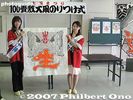
The new kite design was then announced. Called Han-jimon (判じもん), the design expresses a certain theme using word play with a pair of animals and one or two kanji characters. 八日市大凧は3年に一度図柄を変える。112 views
|
|
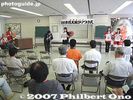
July 7, 2007: The making of the giant kite started with Noritsuke Pasting Ceremony where the new design was announced and dignitaries pasted together the first pieces of the kite paper.107 views
|
|

The top kanji is "yorokobu" (joyfulness) which can also be read as "ki." The pair of hawks 鷹 can be read as "yo." And the bottom kanji is "sei" (living). It's "Kyosei."104 views
|
|

How they do it: First they cut along the outline of the picture leaving ample space. Then they cut it perpendicular to the edge to make paper flaps.104 views
|
|

They introduced the three best designs. 最優秀作品はなく、3点の優秀賞作品を参考に保存会が決めた。102 views
|
|

Wing portion after paper cutting.101 views
|
|

Tying the bamboo frame is considered to be one of the more tedious tasks, so we were rewarded with a pair of gloves with the kite design. These gloves will also give us higher priority to pull the kite during the kite festival.99 views
|
|

98 views
|
|

Higashi-Omi mayor Nakamura Koichi explains the design. "Kyosei" 共生 means to co-exist (i.e. man and nature) or to live together harmoniously. 中村功一市長97 views
|
|

People sign their names on a washi sheet.97 views
|
|

July 16, 2007: Initial sketching and vermilion painting. A sketch of the design was made with a charcoal pencil. 下絵・墨96 views
|
|

July 31, 2007: Bamboo frame work and picture-edge frame work. 骨組(絵骨)Hone-gumi (Ebone)96 views
|
|

Before announcing the final kite design, they announced the three best (but not winning) design entries. The public was invited to submit kite designs based on the theme of "Life" or inochi.95 views
|
|
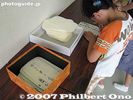
There are also smaller sheets of paper where you can write a wish and sign your name. Paste will be applied to these sheets which will be used to fasten the bamboo frame to the giant paper.95 views
|
|

Twenty-six design entries were submitted this year. There was no top winner, so the final design was based on the three best designs. This design features the kanji "Yorokobu" or joyfulness. 今回のテーマは「いのち」94 views
|
|

A diagonal grid of thin, rod-like bamboo criss-crossed the entire kite. They are now using string to tie the bamboo intersections.94 views
|
|

Aug. 5, 2007: Paper cutting 切り抜き Kiri-nuki. First they reversed the kite paper so the bottom side was up. Then they re-installed the bamboo grid as shown here.94 views
|
|

The paper flaps are applied with paste and then folded over the bamboo rod.94 views
|
|

Entrance to the annex and a sign indicating the day's event or work. Today, July 7, 2007, was the Noritsuke Pasting Ceremony. 八日市大凧まつり のりつけ式93 views
|
|

Group photo. Quite a few people worked during this 3-hour afternoon session.93 views
|
|

July 8, 2007: On the day after the pasting ceremony, the Kamitsugi or paper joining was next. 紙継ぎ92 views
|
|

The design sketch is being completed.91 views
|
|

The paper is Mino Washi, from Gifu Prefecture. It is white, and surprisingly thin. I thought it would be thicker. Six or so sheets are stacked while slightly spread apart.90 views
|
|

Each person holds one edge-pasted sheet and line up to align and join the sheet. Each sheet measures about 90 cm by 60 cm. There are also half-size sheets.89 views
|
|
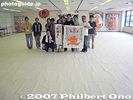
After every kite-making session, they take a picture of all the volunteer participants. It was very interesting. Anybody can participate on any day. Call the kite museum for schedule details: 0748-23-0081.89 views
|
|

They used a wide brush to apply paste to the edges of a piece of kite paper.88 views
|
|

The kite design announcement and pasting ceremony lasted an hour, after which a group photo was taken.88 views
|
|

The stacked paper is put on a table where water-based paste is applied to one horizontal and one vertical paper edge.88 views
|
|

The sheets are joined in the same pattern as a brick wall. Every other row of sheets has a half sheet along the edge. Notice the autographs of people on the paper.88 views
|
|

Local cable TV station also came to cover the kite-making progress.88 views
|
|

Tied bamboo intersections. The rod-like bamboo are supported by larger pieces of bamboo.88 views
|
|

The bamboo grid was temporarily fixed with weights and some tape.88 views
|
|
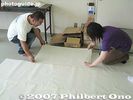
The last sheet is pasted and joined. The job was finished in 3 hours.87 views
|
|

The giant kite paper is finished, taking up the floor space of the entire room.87 views
|
|

The giant kite's main and largest kanji character "sei" is painted in vermilion.87 views
|
|

Vermilion paint87 views
|
|

Wing corner87 views
|
|

Kite edges are lined with a thicker bamboo to which the rod-like bamboo are tied.87 views
|
|

The bamboo frame work is done after the kite design is painted.87 views
|
|
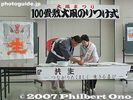
More dignitaries paste the sheets of kite paper together.86 views
|
|

The work proceeds.86 views
|
|

86 views
|
|

86 views
|
|

Bamboo rods and sticks.86 views
|
|

Still more tying to do.86 views
|
|

The pasted pieces are laid to dry.85 views
|
|

A plastic bucket (the same kind used when you take a bath) with paint and a brush is used.85 views
|
|

Spots of white are made on purpose to give a brush stroke effect.85 views
|
|

The red and ornage colors are painted first on the kite, while the black and gray colors are painted later.85 views
|
|

The sketch of the hawk is completed.85 views
|
|

This intricate bamboo frame supports the kite paper so it does not flap around like normal paper.85 views
|
|

Wing85 views
|
|

They joined two sheets of kite paper together. This marked the first step in making the kite. The finished kite paper will consist of a few hundred washi paper sheets pasted together.84 views
|
|

Anybody can help do this. The public is invited to sign their names on a sheet and paste it to the big kite paper.84 views
|
|

A brush stroke effect84 views
|
|

84 views
|
|

Hawk eye painted.84 views
|
|

84 views
|
|

The bamboo grid is carefully aligned with the kite design.84 views
|
|

Wing portion before paper cutting.84 views
|
|

The mayor and one of the kite design artists wear a sash and pose for a picture before proceeding with the Noritsuke Ceremony.83 views
|
|

So the giant kite is actually made of many smaller sheets of paper joined together. Notice my "philbert" autograph on the bottom.83 views
|
|

83 views
|
|

83 views
|
|

83 views
|
|

82 views
|
|

Plastic pails and brushes82 views
|
|

Hawk eye82 views
|
|

Group photo of those who worked on the kite this time. This session was 9:30 am to noon.82 views
|
|

Besides the diagonal grid of bamboo rods, a bamboo rod is also fastened along the edges of the design where the paper will be cut out (or carved out). These bamboo rods keep the edges of the cut-out paper taut. Otherwise it would flap around in the wind.82 views
|
|

The size of the room almost exactly matches the size of the giant kite which is 12 meters by 13 meters or 100 tatami mats.81 views
|
|

"Yorokobu" or "ki"81 views
|
|

81 views
|
|

Intricate bamboo grid/frame fitting all shapes along the edges.81 views
|
|

We were then invited to sign our names on the kite paper.80 views
|
|

The "yorokobu" or "ki" kanji is also painted on the same day.80 views
|
|

80 views
|
|

Starting at 9:30 am, members of the giant kite preservation society began pasting and joining about 400 sheets of washi paper to make the giant kite paper.79 views
|
|

Vermilion painting of "sei" is complete.79 views
|
|

The top two rows of washi sheets already pasted together.77 views
|
|
|
|